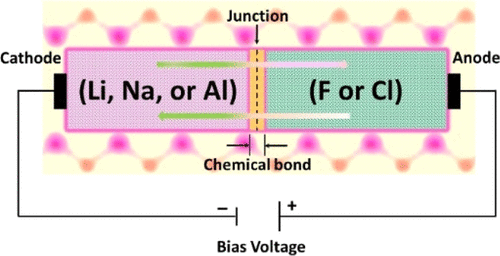当前位置:
X-MOL 学术
›
ACS Appl. Electron. Mater.
›
论文详情
Our official English website, www.x-mol.net, welcomes your
feedback! (Note: you will need to create a separate account there.)
One-Dimensional Metal–Halogen Junctions inside Extended Si6O6 Nanotubes Performing as Quasi-Single-Electron Diodes
ACS Applied Electronic Materials ( IF 4.3 ) Pub Date : 2020-09-09 , DOI: 10.1021/acsaelm.0c00567 Roberto Rivelino 1 , Fernando de B. Mota 1 , Thiago A. de Assis 1, 2 , Caio P. de Castro 1 , Caio M. C. de Castilho 1, 2
ACS Applied Electronic Materials ( IF 4.3 ) Pub Date : 2020-09-09 , DOI: 10.1021/acsaelm.0c00567 Roberto Rivelino 1 , Fernando de B. Mota 1 , Thiago A. de Assis 1, 2 , Caio P. de Castro 1 , Caio M. C. de Castilho 1, 2
Affiliation

|
We propose and simulate one-dimensional (1D) diode devices exhibiting an ionic single metal–halogen interaction inside a semiconducting SiO-based nanotube (SiONT). After theoretically demonstrating the structural and dynamical stability of this tubular archetype, that is, Si6O6, we investigate the quantum transport of doped devices under applied bias voltages. The self-consistent density matrices of the diodes are calculated using the Keldysh nonequilibrium Green’s function technique, coupled to the electrodes via their exact self-energies. We examine devices containing 1D quantum wires of Li, Na, and Al, as cathodes, and of halogen atoms (F and Cl), as anodes, with a 50:50 atomic composition inside a SiONT. These devices give rise to ionic diatomic molecular junctions, ultimately allowing a single-electron transport. We show that the resulting alkali–halogen 1D diodes exhibit a region of current suppression, such as in Si-based p–n devices, with a fair rectifying behavior at [−2.0, +2.0 V]. For Si6O6 doped with ···Li···Li–F···F···, after the cut-in voltage, we observe a tunneling effect, with a significant negative differential resistance region. In the case of ···Al···Al–F···F··· doping, a Schottky-type contact emerges in the junction. These devices exhibit adjustable threshold voltages (0.5–1.0 V) and rectification ratios (51–2619) by the electrodes’ atomic composition. Our results suggest that these actually 1D diodes, based on a single metal–halogen bond inside a SiONT, are functional and may be used as prototypes for the development of quantum logic gates. Indeed, the proposed diatomic molecular tunnel junctions may exhibit quantum interference phenomenon, entangling bonding and antibonding states, spatially protected from the environment by an insulating nanotube.
中文翻译:

扩展Si 6 O 6纳米管中的一维金属-卤素结,表现为准单电子二极管
我们提出并模拟一维(1D)二极管器件,该器件在半导体SiO基纳米管(SiONT)内表现出离子单金属-卤素相互作用。在理论上证明了这种管状原型即Si 6 O 6的结构和动力学稳定性之后,我们研究了施加偏压下掺杂器件的量子传输。二极管的自洽密度矩阵是使用Keldysh非平衡格林函数技术计算的,并通过其精确的自能量耦合到电极。我们检查了包含一维Li,Na和Al的量子线的器件,它们是阴极,而卤素原子(F和Cl)作为阳极,其SiONT内部原子组成为50:50。这些装置引起离子双原子分子结,最终允许单电子传输。我们表明,所得到的碱-卤素一维二极管表现出电流抑制区域,例如在基于Si的p-n器件中,在[-2.0,+2.0 V]时具有公平的整流行为。对于Si 6 O 6掺杂与······李李-F···˚F...,之后切入电压,我们观察到隧道效应,具有显著负微分电阻区域。在掺杂········································的情况下,结中出现肖特基型的接触。这些设备通过电极的原子组成表现出可调节的阈值电压(0.5–1.0 V)和整流比(51–2619)。我们的结果表明,这些实际的一维二极管基于SiONT内部的单个金属-卤素键,具有功能,可以用作开发量子逻辑门的原型。实际上,所提出的双原子分子隧道结可能表现出量子干涉现象,缠结键和反键状态,并通过绝缘纳米管在空间上免受环境的影响。
更新日期:2020-10-28
中文翻译:

扩展Si 6 O 6纳米管中的一维金属-卤素结,表现为准单电子二极管
我们提出并模拟一维(1D)二极管器件,该器件在半导体SiO基纳米管(SiONT)内表现出离子单金属-卤素相互作用。在理论上证明了这种管状原型即Si 6 O 6的结构和动力学稳定性之后,我们研究了施加偏压下掺杂器件的量子传输。二极管的自洽密度矩阵是使用Keldysh非平衡格林函数技术计算的,并通过其精确的自能量耦合到电极。我们检查了包含一维Li,Na和Al的量子线的器件,它们是阴极,而卤素原子(F和Cl)作为阳极,其SiONT内部原子组成为50:50。这些装置引起离子双原子分子结,最终允许单电子传输。我们表明,所得到的碱-卤素一维二极管表现出电流抑制区域,例如在基于Si的p-n器件中,在[-2.0,+2.0 V]时具有公平的整流行为。对于Si 6 O 6掺杂与······李李-F···˚F...,之后切入电压,我们观察到隧道效应,具有显著负微分电阻区域。在掺杂········································的情况下,结中出现肖特基型的接触。这些设备通过电极的原子组成表现出可调节的阈值电压(0.5–1.0 V)和整流比(51–2619)。我们的结果表明,这些实际的一维二极管基于SiONT内部的单个金属-卤素键,具有功能,可以用作开发量子逻辑门的原型。实际上,所提出的双原子分子隧道结可能表现出量子干涉现象,缠结键和反键状态,并通过绝缘纳米管在空间上免受环境的影响。











































 京公网安备 11010802027423号
京公网安备 11010802027423号